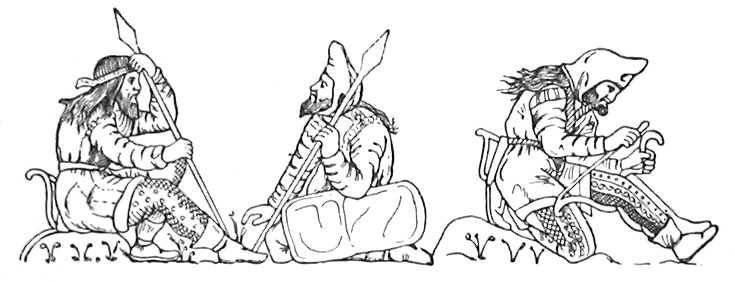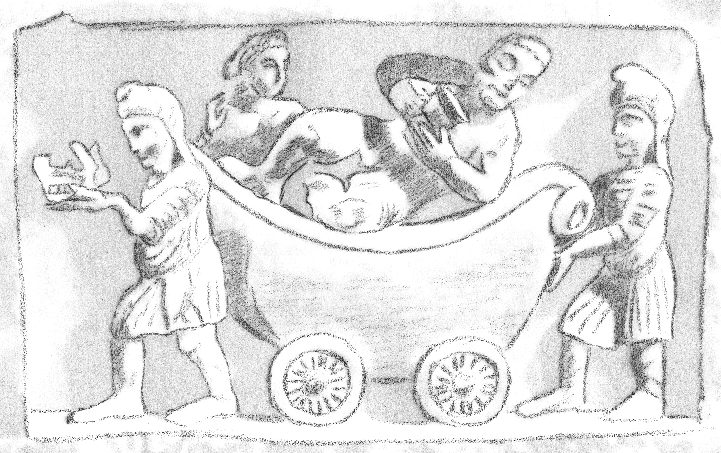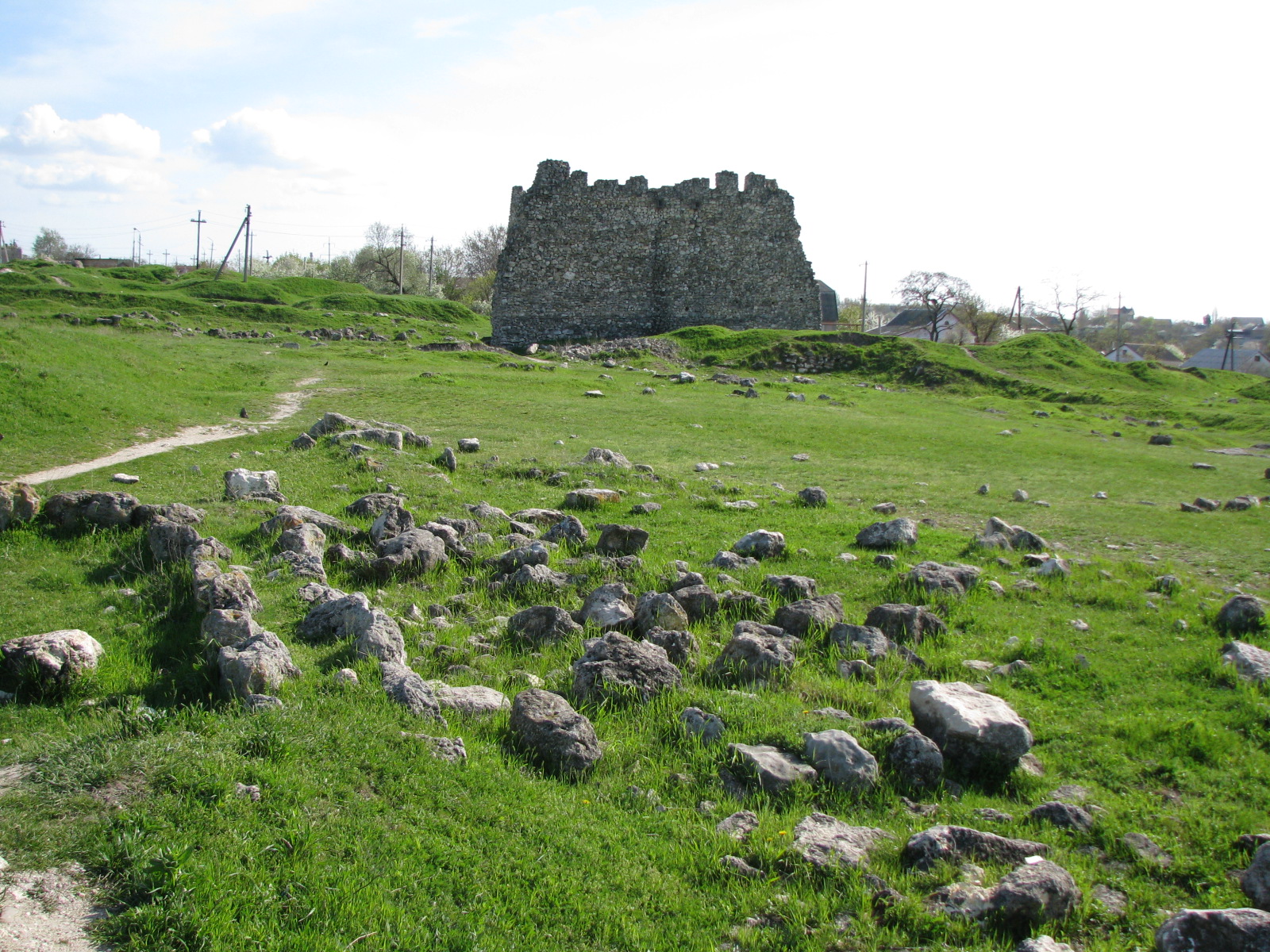Scythian Neapolis on:
[Wikipedia]
[Google]
[Amazon]
Scythian Neapolis ( el, Σκυθική Νεάπολις), also known as Kermenchik, was a settlement that existed from the end of the 3rd century BC until the second half of the 3rd century AD and was previously considered a town of the
 The inhabitants of Scythian Neapolis shifted, during the second half of the 1st century and the third quarter of the 2nd century, moved from a mixed agricultural and nomadic landscape to primarily nomadic one, with changes in the fortress layout and plans demonstrating this. During this time, imported objects were a primary archaeological find with numerous red-slip pottery, glass vessels and metal items, including ‘enamelled Roman brooches’ (Vysotskaya as cited in Zaytsev, 2004). Daily life during this period included simple female toiletry items, such as mirrors and curling irons for hairstyling, and horse equipment that varied in skill. Kitchenware was identified as locally sourced, hand-made jugs, pots, open-vessels and cups with some imported red-slip plates, jugs and cups also being found. Battle armour included long and short Sarmatian-style swords and iron head arrows. Graffiti was found during this time which has stimulated a debate on their meaning. There has been debate on their meaning with O.D. Dashevskaya (1962) suggesting that they were individual ‘autographs’ by the residents during ceremonies whereas other historians theorise that they have ritualistic meaning or were the works of
The inhabitants of Scythian Neapolis shifted, during the second half of the 1st century and the third quarter of the 2nd century, moved from a mixed agricultural and nomadic landscape to primarily nomadic one, with changes in the fortress layout and plans demonstrating this. During this time, imported objects were a primary archaeological find with numerous red-slip pottery, glass vessels and metal items, including ‘enamelled Roman brooches’ (Vysotskaya as cited in Zaytsev, 2004). Daily life during this period included simple female toiletry items, such as mirrors and curling irons for hairstyling, and horse equipment that varied in skill. Kitchenware was identified as locally sourced, hand-made jugs, pots, open-vessels and cups with some imported red-slip plates, jugs and cups also being found. Battle armour included long and short Sarmatian-style swords and iron head arrows. Graffiti was found during this time which has stimulated a debate on their meaning. There has been debate on their meaning with O.D. Dashevskaya (1962) suggesting that they were individual ‘autographs’ by the residents during ceremonies whereas other historians theorise that they have ritualistic meaning or were the works of
 The religious beliefs of the Scythians are not fully understood by historians however many believe they were polytheists, with a belief in the afterlife. This is evidenced by the grave goods found in burial sites, such as group burials found within the catacombs located in the Eastern Necropolis in Scythian Neapolis. These
The religious beliefs of the Scythians are not fully understood by historians however many believe they were polytheists, with a belief in the afterlife. This is evidenced by the grave goods found in burial sites, such as group burials found within the catacombs located in the Eastern Necropolis in Scythian Neapolis. These
 During the Scythian period a large stone wall surrounded the settlement as a defence method against the Sarmatians and had a large gate, flanked by two defence towers. Inside the walls Scythian Neapolis had public buildings, which were influenced, to varying degrees, by
During the Scythian period a large stone wall surrounded the settlement as a defence method against the Sarmatians and had a large gate, flanked by two defence towers. Inside the walls Scythian Neapolis had public buildings, which were influenced, to varying degrees, by
 The mausoleum of King Skiluros was first excavated in 1946 by P.N. Schulz, N.N. Pogrebova, O.I. Dombrovsky, E.A. Bolotnikova, A.N. Karasev, Kh.I. Kris, T.Ya Kobetz, V.A. Golovkina, and T.A. Globenko. Constructed circa 115 BCE near the central gates it was the second mausoleum built in Scythian Neapolis and its location was beyond the walls of Scythian Neapolis. Skiluros’ body was laid on the crypt floor with the head being dressed in a ‘semi-spherical cap ornamented with gold plaques. Several silver and bronze broaches placed on his chest before falling to the pelvis area and an iron helmet was also excavated but its original location is unknown. There has been academic contention over the meaning of lines 4-8 from an inscription found within the mausoleum with some historians believing that those lines were describing Argotas, not King Skiluros.
The Argotas mausoleum
The mausoleum of King Skiluros was first excavated in 1946 by P.N. Schulz, N.N. Pogrebova, O.I. Dombrovsky, E.A. Bolotnikova, A.N. Karasev, Kh.I. Kris, T.Ya Kobetz, V.A. Golovkina, and T.A. Globenko. Constructed circa 115 BCE near the central gates it was the second mausoleum built in Scythian Neapolis and its location was beyond the walls of Scythian Neapolis. Skiluros’ body was laid on the crypt floor with the head being dressed in a ‘semi-spherical cap ornamented with gold plaques. Several silver and bronze broaches placed on his chest before falling to the pelvis area and an iron helmet was also excavated but its original location is unknown. There has been academic contention over the meaning of lines 4-8 from an inscription found within the mausoleum with some historians believing that those lines were describing Argotas, not King Skiluros.
The Argotas mausoleum
 This mausoleum was built before the mausoleum of Skiluros, with excavations undertaken in 1999. It was built after the city destroying fire of 128 BC, alongside the palace, and is one the structures that illustrate the Greek influence over architecture with Doric capitals and many Greek reliefs, sculptures, inscriptions and architectural details being found within the mausoleum. This structure provided new insights into the Scythian noble Argotas and Late Scythian history. It was square in shape, built near the royal palace and the majority of reliefs and sculptures were found here. Historians, such as Ivantchik (2019), have theorised that because this structure was built, Argotas has a major role within the settlement and Scythian nobility at the time. An inscription, specifically lines 4-8, found within the Mausoleum has stimulated an academic debate amongst historians with some believing it was about King Skiluros whilst others suggest the epitaph was about Argotas, an individual apart of the Scythian nobility. Makarov (2019) states that Argotas came from the ruling class of Scythians and reflects the close relationship between the royal families of Bosporus and Scythia during the second half of the 2nd century BC. This inscription provides evidence that the King of Neapolis Scythian regarded themselves as the ruler of Scythia as well as indicating a focus of the external policies in Scythia which was maintaining ‘friendly relations’.
This mausoleum was built before the mausoleum of Skiluros, with excavations undertaken in 1999. It was built after the city destroying fire of 128 BC, alongside the palace, and is one the structures that illustrate the Greek influence over architecture with Doric capitals and many Greek reliefs, sculptures, inscriptions and architectural details being found within the mausoleum. This structure provided new insights into the Scythian noble Argotas and Late Scythian history. It was square in shape, built near the royal palace and the majority of reliefs and sculptures were found here. Historians, such as Ivantchik (2019), have theorised that because this structure was built, Argotas has a major role within the settlement and Scythian nobility at the time. An inscription, specifically lines 4-8, found within the Mausoleum has stimulated an academic debate amongst historians with some believing it was about King Skiluros whilst others suggest the epitaph was about Argotas, an individual apart of the Scythian nobility. Makarov (2019) states that Argotas came from the ruling class of Scythians and reflects the close relationship between the royal families of Bosporus and Scythia during the second half of the 2nd century BC. This inscription provides evidence that the King of Neapolis Scythian regarded themselves as the ruler of Scythia as well as indicating a focus of the external policies in Scythia which was maintaining ‘friendly relations’.
Official website
* * {{Tourist attractions in Crimea Royal residences in Ukraine Populated places established in the 3rd century BC Populated places disestablished in the 3rd century Archaeological sites in Ukraine Ancient Crimea Bosporan Kingdom Former populated places in Eastern Europe Simferopol Scythians Iranian archaeological sites Populated places in ancient Scythia Cultural heritage monuments of federal significance in Crimea
Tauric Chersonesus
The recorded history of the Crimean Peninsula, historically known as ''Tauris'', ''Taurica'' ( gr, Ταυρική or Ταυρικά), and the ''Tauric Chersonese'' ( gr, Χερσόνησος Ταυρική, "Tauric Peninsula"), begins around the ...
(Crimea) and was mentioned by Strabo
Strabo''Strabo'' (meaning "squinty", as in strabismus) was a term employed by the Romans for anyone whose eyes were distorted or deformed. The father of Pompey was called " Pompeius Strabo". A native of Sicily so clear-sighted that he could s ...
as being the fortress and palace where the Scythian kings resided. It is regarded as the capital of the Late Scythian Kingdom and the capital of ‘Great Scythia’. The archaeological ruins sit on the outskirts of the present-day Simferopol
Simferopol () is the second-largest city in the Crimean Peninsula. The city, along with the rest of Crimea, is internationally recognised as part of Ukraine, and is considered the capital of the Autonomous Republic of Crimea. However, it is ...
. This city was the centre of the Crimean Scythian
The Scythians or Scyths, and sometimes also referred to as the Classical Scythians and the Pontic Scythians, were an ancient Eastern
* : "In modern scholarship the name 'Sakas' is reserved for the ancient tribes of northern and eastern Centra ...
tribes, led by Skilurus and Palacus. The town ruled over a small kingdom, covering the lands between the lower Dnieper
}
The Dnieper () or Dnipro (); , ; . is one of the major transboundary rivers of Europe, rising in the Valdai Hills near Smolensk, Russia, before flowing through Belarus and Ukraine to the Black Sea. It is the longest river of Ukraine an ...
river and Crimea
Crimea, crh, Къырым, Qırım, grc, Κιμμερία / Ταυρική, translit=Kimmería / Taurikḗ ( ) is a peninsula in Ukraine, on the northern coast of the Black Sea, that has been occupied by Russia since 2014. It has a p ...
. Between the end of the 4th c. BC to the beginning of the 3rd c. BC historians suggest that the Kizil-Koba culture Kizil-Koba is a Middle Paleolithic culture belonging to a people who lived in the 9th–8th millennia BC in the Eastern Crimean territory and ancestral to Tauri. It is known as the first Eastern European settlement, where Neanderthal remains were fo ...
occupied the area of Scythian Neapolis before any Scythian artefacts were found. Neapolis was destroyed halfway through the 3rd century AD by the Goths
The Goths ( got, 𐌲𐌿𐍄𐌸𐌹𐌿𐌳𐌰, translit=''Gutþiuda''; la, Gothi, grc-gre, Γότθοι, Gótthoi) were a Germanic people who played a major role in the fall of the Western Roman Empire and the emergence of medieval Euro ...
. This settlement was first excavated in 1945 by Schultz and Golovkina.
Geography
The geographical features of Scythian Neapolis include being located on a plateau on the ‘Petrovskiye rocks in Simferopol’. Its climate has been described as having long, dry and wind filled summer and winter periods as well as having moderate precipitation levels. The area of the capital was distinguished by forests and rich vegetation which includes wood such as oak, pine, poplar and alder around the fortress.History
Culture The cultural landscape of Scythian Neapolis was diverse, with not only Scythian culture present but also the ‘sedentary Tauri’ and ‘the Hellenized population of the chorai of the Greek cities’. Ivantchik (2019) states that the Scythians of the time, including those inhabiting Scythian Neapolis, were closer to Hellenistic states in comparison to the ‘Scythians’ nomadic kingdom of the 4th century BC’. Evidence from craniology research in this area also indicates that no less than two groups of individuals of different origins were present in Scythian Neapolis. During the Hellenistic period, which is between 128-124 BC, there were only minor signs of agriculture and cattle breeding which suggests that during this period the individuals that lived in Scythian Neapolis were only semi-settled. The absence of buildings and with ‘images of horsemen in the ornamental fields,… nd��the mix of animal bones found among cooking waste’ in the Palace complex further suggests this. Archaeological evidence of ‘tiles, jugs, and cups, lamos and alters, and terracotta figurines’ illustrate that pottery manufacturing occurred, with it being primarily traded locally and used practically. Other historians commenting on it being 'somewhat unambitious'. This is demonstrated as handmade cooking ware, toiletries (tweezers, mirrors) and tools (knives, spinning wheels and needles) are archaeological objects found from this period. Imports identified during this period includeamphorae
An amphora (; grc, ἀμφορεύς, ''amphoreús''; English plural: amphorae or amphoras) is a type of container with a pointed bottom and characteristic shape and size which fit tightly (and therefore safely) against each other in storag ...
from ‘Rhodes
Rhodes (; el, Ρόδος , translit=Ródos ) is the largest and the historical capital of the Dodecanese islands of Greece. Administratively, the island forms a separate municipality within the Rhodes regional unit, which is part of the S ...
, Sinopa, Chersonesos, and Knidos
Knidos or Cnidus (; grc-gre, Κνίδος, , , Knídos) was a Greek city in ancient Caria and part of the Dorian Hexapolis, in south-western Asia Minor, modern-day Turkey. It was situated on the Datça peninsula, which forms the southern side ...
’ as well as tableware, ornaments and ‘mould-made cups’, with the Southern Palace being the main area of relocation for them as of these objects were found there. The inhabitants of Scythian Neapolis lead a very simple life during this period, with open fires being utilised for food preparation and warmth. The Southern Palace was the expectation, with luxury goods including a diverse range of Greek ceramics, Greek beds and imported bronze mirrors, were discovered. Zaytsev (2004) also believes that dice was a popular game, with more than 30 sheep astragali were found in one of the palace megarons.
Between the end of the 2nd century BCE to the middle of the 1st century CE more barbarian material culture was present amongst the individuals located at Scythian Neapolis. Through archaeological evidence there does not appear any development in the crafts, with pottery, bone and wood implements, yarn and cloth still being used internally and produced in small numbers. Imports, such as brown and red-slip tableware, special ornaments and beads, Roman items and Egyptian faience
Faience or faïence (; ) is the general English language term for fine tin-glazed pottery. The invention of a white pottery glaze suitable for painted decoration, by the addition of an oxide of tin to the slip of a lead glaze, was a major ...
illustrate a bigger variety of goods being traded during this time, specifically stating during the 1st century CE. Whilst there was an increase in animal husbandry, evidenced through the finds of bones throughout the farmland areas in Scythian Neapolis, agriculture was not abundant as there is a lack of tools found during this period, except for some crude stone pestles used for grain processing.
 The inhabitants of Scythian Neapolis shifted, during the second half of the 1st century and the third quarter of the 2nd century, moved from a mixed agricultural and nomadic landscape to primarily nomadic one, with changes in the fortress layout and plans demonstrating this. During this time, imported objects were a primary archaeological find with numerous red-slip pottery, glass vessels and metal items, including ‘enamelled Roman brooches’ (Vysotskaya as cited in Zaytsev, 2004). Daily life during this period included simple female toiletry items, such as mirrors and curling irons for hairstyling, and horse equipment that varied in skill. Kitchenware was identified as locally sourced, hand-made jugs, pots, open-vessels and cups with some imported red-slip plates, jugs and cups also being found. Battle armour included long and short Sarmatian-style swords and iron head arrows. Graffiti was found during this time which has stimulated a debate on their meaning. There has been debate on their meaning with O.D. Dashevskaya (1962) suggesting that they were individual ‘autographs’ by the residents during ceremonies whereas other historians theorise that they have ritualistic meaning or were the works of
The inhabitants of Scythian Neapolis shifted, during the second half of the 1st century and the third quarter of the 2nd century, moved from a mixed agricultural and nomadic landscape to primarily nomadic one, with changes in the fortress layout and plans demonstrating this. During this time, imported objects were a primary archaeological find with numerous red-slip pottery, glass vessels and metal items, including ‘enamelled Roman brooches’ (Vysotskaya as cited in Zaytsev, 2004). Daily life during this period included simple female toiletry items, such as mirrors and curling irons for hairstyling, and horse equipment that varied in skill. Kitchenware was identified as locally sourced, hand-made jugs, pots, open-vessels and cups with some imported red-slip plates, jugs and cups also being found. Battle armour included long and short Sarmatian-style swords and iron head arrows. Graffiti was found during this time which has stimulated a debate on their meaning. There has been debate on their meaning with O.D. Dashevskaya (1962) suggesting that they were individual ‘autographs’ by the residents during ceremonies whereas other historians theorise that they have ritualistic meaning or were the works of Sarmatian
The Sarmatians (; grc, Σαρμαται, Sarmatai; Latin: ) were a large confederation of ancient Eastern Iranian equestrian nomadic peoples of classical antiquity who dominated the Pontic steppe from about the 3rd century BC to the 4th cen ...
conquerors (Vysotskaya and Puzdrovsky as cited in Zaystev, 2004). Zaytsev (2004) states that culturally, this period was heavily influenced by the Sarmatian culture as well as the neighbouring settlements of Bosphorus
The Bosporus Strait (; grc, Βόσπορος ; tr, İstanbul Boğazı 'Istanbul strait', colloquially ''Boğaz'') or Bosphorus Strait is a natural strait and an internationally significant waterway located in Istanbul in northwestern Tu ...
and Chersonesos.
During the end of the 2nd century to the middle of the 3rd century, which was the last period before the settlement was destroyed by the Goths, archaeological evidence from Scythian Neapolis suggests that its agricultural sector progressed with the settlement being considered an ‘agricultural hub’ due to the significant volumes of grain storage uncovered. Zaystev (2004) states that the population demonstrated the general characteristics of group settlements in the Black Sea region
The Black Sea Region ( tr, Karadeniz Bölgesi) is a geographical region of Turkey. The largest city in the region is Samsun. Other big cities are Trabzon, Ordu, Tokat, Giresun, Rize, Amasya and Sinop.
It is bordered by the Marmara Regio ...
; ‘decline in lifestyle, total barbarization, and deep religious syncretism’. The archaeological presence of permanent granaries, hand-mills and primitive grain grain-pestles as well as carbonised apple and vines, which demonstrate the presence of viticulture
Viticulture (from the Latin word for '' vine'') or winegrowing (wine growing) is the cultivation and harvesting of grapes. It is a branch of the science of horticulture. While the native territory of '' Vitis vinifera'', the common grape vine, r ...
and horticulture
Horticulture is the branch of agriculture that deals with the art, science, technology, and business of plant cultivation. It includes the cultivation of fruits, vegetables, nuts, seeds, herbs, sprouts, mushrooms, algae, flowers, seaweeds and no ...
, further demonstrates the steady and settled agricultural sector present during this time. Excavators found the bones of horses, cows, goats and sheep which historians believe indicate that hunting games occurred and played a role in the economy of this settlement. Home-based production of pottery and items made of bone, wool, yarn and cloth was still evident during this period whilst imports of red-slip amphorae
An amphora (; grc, ἀμφορεύς, ''amphoreús''; English plural: amphorae or amphoras) is a type of container with a pointed bottom and characteristic shape and size which fit tightly (and therefore safely) against each other in storag ...
jugs from Bosphorus, and red-slip pottery from Chersonesos have also been found indicating trade with neighbouring settlements was still occurring. In these amphorae some contained wines which had been imported from Rhodes, Cnidus, Cos and Sinope.
Religion
 The religious beliefs of the Scythians are not fully understood by historians however many believe they were polytheists, with a belief in the afterlife. This is evidenced by the grave goods found in burial sites, such as group burials found within the catacombs located in the Eastern Necropolis in Scythian Neapolis. These
The religious beliefs of the Scythians are not fully understood by historians however many believe they were polytheists, with a belief in the afterlife. This is evidenced by the grave goods found in burial sites, such as group burials found within the catacombs located in the Eastern Necropolis in Scythian Neapolis. These catacombs
Catacombs are man-made subterranean passageways for religious practice. Any chamber used as a burial place is a catacomb, although the word is most commonly associated with the Roman Empire.
Etymology and history
The first place to be referred ...
were structured in terms of wealth, with the ‘deepest and richest…to shallower ones with a smaller range of objects’ being found. The types of grave goods found within these burials include handmade pottery, knives, jewellery such as small rings and beads, earrings and small bells and pendants.
Architecture
 During the Scythian period a large stone wall surrounded the settlement as a defence method against the Sarmatians and had a large gate, flanked by two defence towers. Inside the walls Scythian Neapolis had public buildings, which were influenced, to varying degrees, by
During the Scythian period a large stone wall surrounded the settlement as a defence method against the Sarmatians and had a large gate, flanked by two defence towers. Inside the walls Scythian Neapolis had public buildings, which were influenced, to varying degrees, by Greek architecture
Ancient Greek architecture came from the Greek-speaking people (''Hellenic'' people) whose culture flourished on the Greek mainland, the Peloponnese, the Aegean Islands, and in colonies in Anatolia and Italy for a period from about 900 BC u ...
as well as construction methods and is demonstrated through the buildings with the archaeological features of columns with capitals, painted plaster, statues and tiled roofs. The residential section was located in the northern part of the town, with small houses for families of a medium income being the most common and houses belonging to rich families being scarce. Over the different periods of time that the Scythian’s occupied this settlement was destroyed multiple times, some by fires but also by Mithradates’ general Diophantos.
Zaytsev (2004) cites Kryzhitsky (1993) by stating that the architecture present in Scythian Neapolis had a ‘mix of Greek/Barbarian building traditions' during the Hellenistic period
In Classical antiquity, the Hellenistic period covers the time in Mediterranean history after Classical Greece, between the death of Alexander the Great in 323 BC and the emergence of the Roman Empire, as signified by the Battle of Actium in ...
. The techniques during this time were ‘relatively primitive’, with materials such as unfired bricks, timber, limestone, and clay being primary ones. Building techniques for dwellings/houses and the defensive walls didn’t differ during this period, with the absence of skilled masons and carpenters is identified through ‘surface and level variances’. The exception to this is the Southern Palace, with parameters of the megaron suggesting a two-storey construction and archaeological evidence illustrating a tiled roof and thick walls. Further construction phases used materials such as ‘well-processed limestone slabs and blocks’ and significant Southern Palace buildings, such as the heroon of Argotus, Mausoleum of Skiluros and Monumental Southern Façade, were professionally built to Greek architectural standards.
Over time, the architectural techniques in Scythian Neapolis scarcely evolved with the palace complexes receiving more sophisticated materials, such as bronze and marble, in comparison to the dwellings and granaries where ‘a steep decline of architectural and building skills’ was observed. This could be a result of the changing circumstances of the individuals residing in Scythian Neapolis, as the barbarian population experienced major changes before the settlement was destroyed.
Major sites
The Mausoleum of King Skiluros The mausoleum of King Skiluros was first excavated in 1946 by P.N. Schulz, N.N. Pogrebova, O.I. Dombrovsky, E.A. Bolotnikova, A.N. Karasev, Kh.I. Kris, T.Ya Kobetz, V.A. Golovkina, and T.A. Globenko. Constructed circa 115 BCE near the central gates it was the second mausoleum built in Scythian Neapolis and its location was beyond the walls of Scythian Neapolis. Skiluros’ body was laid on the crypt floor with the head being dressed in a ‘semi-spherical cap ornamented with gold plaques. Several silver and bronze broaches placed on his chest before falling to the pelvis area and an iron helmet was also excavated but its original location is unknown. There has been academic contention over the meaning of lines 4-8 from an inscription found within the mausoleum with some historians believing that those lines were describing Argotas, not King Skiluros.
The Argotas mausoleum
The mausoleum of King Skiluros was first excavated in 1946 by P.N. Schulz, N.N. Pogrebova, O.I. Dombrovsky, E.A. Bolotnikova, A.N. Karasev, Kh.I. Kris, T.Ya Kobetz, V.A. Golovkina, and T.A. Globenko. Constructed circa 115 BCE near the central gates it was the second mausoleum built in Scythian Neapolis and its location was beyond the walls of Scythian Neapolis. Skiluros’ body was laid on the crypt floor with the head being dressed in a ‘semi-spherical cap ornamented with gold plaques. Several silver and bronze broaches placed on his chest before falling to the pelvis area and an iron helmet was also excavated but its original location is unknown. There has been academic contention over the meaning of lines 4-8 from an inscription found within the mausoleum with some historians believing that those lines were describing Argotas, not King Skiluros.
The Argotas mausoleum
 This mausoleum was built before the mausoleum of Skiluros, with excavations undertaken in 1999. It was built after the city destroying fire of 128 BC, alongside the palace, and is one the structures that illustrate the Greek influence over architecture with Doric capitals and many Greek reliefs, sculptures, inscriptions and architectural details being found within the mausoleum. This structure provided new insights into the Scythian noble Argotas and Late Scythian history. It was square in shape, built near the royal palace and the majority of reliefs and sculptures were found here. Historians, such as Ivantchik (2019), have theorised that because this structure was built, Argotas has a major role within the settlement and Scythian nobility at the time. An inscription, specifically lines 4-8, found within the Mausoleum has stimulated an academic debate amongst historians with some believing it was about King Skiluros whilst others suggest the epitaph was about Argotas, an individual apart of the Scythian nobility. Makarov (2019) states that Argotas came from the ruling class of Scythians and reflects the close relationship between the royal families of Bosporus and Scythia during the second half of the 2nd century BC. This inscription provides evidence that the King of Neapolis Scythian regarded themselves as the ruler of Scythia as well as indicating a focus of the external policies in Scythia which was maintaining ‘friendly relations’.
This mausoleum was built before the mausoleum of Skiluros, with excavations undertaken in 1999. It was built after the city destroying fire of 128 BC, alongside the palace, and is one the structures that illustrate the Greek influence over architecture with Doric capitals and many Greek reliefs, sculptures, inscriptions and architectural details being found within the mausoleum. This structure provided new insights into the Scythian noble Argotas and Late Scythian history. It was square in shape, built near the royal palace and the majority of reliefs and sculptures were found here. Historians, such as Ivantchik (2019), have theorised that because this structure was built, Argotas has a major role within the settlement and Scythian nobility at the time. An inscription, specifically lines 4-8, found within the Mausoleum has stimulated an academic debate amongst historians with some believing it was about King Skiluros whilst others suggest the epitaph was about Argotas, an individual apart of the Scythian nobility. Makarov (2019) states that Argotas came from the ruling class of Scythians and reflects the close relationship between the royal families of Bosporus and Scythia during the second half of the 2nd century BC. This inscription provides evidence that the King of Neapolis Scythian regarded themselves as the ruler of Scythia as well as indicating a focus of the external policies in Scythia which was maintaining ‘friendly relations’.
References
Sources
* * * * * * * *External links
Official website
* * {{Tourist attractions in Crimea Royal residences in Ukraine Populated places established in the 3rd century BC Populated places disestablished in the 3rd century Archaeological sites in Ukraine Ancient Crimea Bosporan Kingdom Former populated places in Eastern Europe Simferopol Scythians Iranian archaeological sites Populated places in ancient Scythia Cultural heritage monuments of federal significance in Crimea